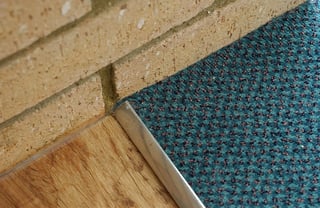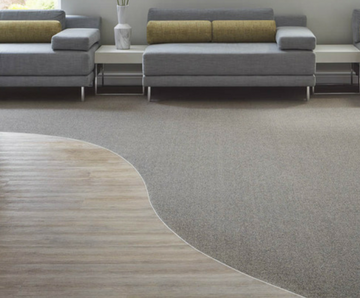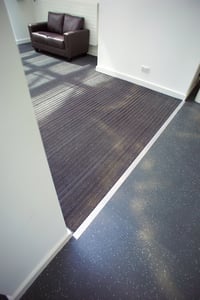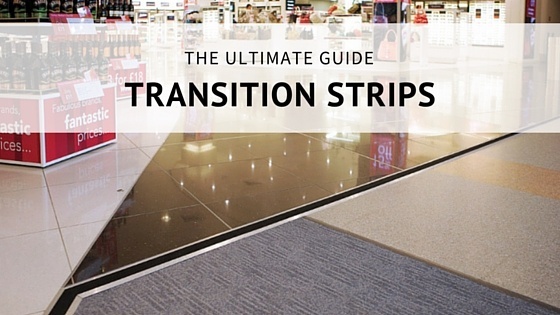What are transition strips?
Transition strips are used when you are joining together two different sections of a building, like offices and a hallway or an open area where flooring types change. They not only serve to make a more pleasing appearance between the two sections, but they also provide safety, adding a prevention measure to those who might trip over an exposed edge.
Transition strips can be made of many different materials, such as PVC, aluminum, stainless steel or bronze, depending on the look that the customer is going for and what the circumstances are for foot traffic or heavier equipment rolling over the area.When are they needed?
 Any area that joins together two different sections of a building or area can benefit from a transition strip. Transition strips are especially important when you are going from one thickness of floor covering to another.
Any area that joins together two different sections of a building or area can benefit from a transition strip. Transition strips are especially important when you are going from one thickness of floor covering to another.
It’s common to have an area that has thick carpet that transitions to concrete or carpet that transitions to another hard surface like wood, laminate or linoleum. If left without something to join them together, the flooring can become damaged at the edges. Also, because of the different levels of flooring, a trip hazard is formed.
How much do they cost?
The price range of transition strips can vary from under $1.00 per foot to over $25.00 per foot.
There are many variables that affect the cost of transition strips. The factor that has the most impact on pricing is the material used. Also contributing to the cost is the setting in which the transition strips will be used (i.e. residential, factory, offices, etc.). On the low end of the price spectrum are the one piece plastic transition strips. You can find these in home improvement and flooring specialty stores. The main advantage of these is price. If your space experiences a lot of foot traffic or heavy rollers or casters, they typically will not work as well
 If you are looking for a higher quality transition strip that’s designed for the commercial industry, consider the ones made by Gradus. They are stronger and more durable than the standard pieces that you will find in retail stores, though they will be more expensive.
If you are looking for a higher quality transition strip that’s designed for the commercial industry, consider the ones made by Gradus. They are stronger and more durable than the standard pieces that you will find in retail stores, though they will be more expensive.
Most Gradus transition strips are composed of two pieces. On the bottom is generally an aluminum base that is screwed and glued directly to the floor surface. The top portion is tapped into the base, forming a clean and safe transition between the two flooring surfaces.
The basic Gradus PVC top and aluminum base pricing starts around $3.50 per linear foot. We also have PVC transition strips with a PVC base that can be curved on site for your radius areas. Gradus has a complete line of luxury trims that can be used in the most upscale environments. Of course, with the glitz and glamour of these profiles comes a higher price range. The finishes available for the luxury trims include, but are not limited to, polished brass, polished chrome, and brushed stainless steel. Gradus also manufactures transition strip profiles that will work in heavily trafficked industrial areas as well as those with ceramic tile.
Transition Strips For Indoor Use
 Gradus transition strips are made exclusively for indoor use. We have profiles that can help with the transitions between the same thickness of flooring (carpet, tile, wood, etc.) or between different thicknesses, as previously mentioned. Basically, if you have an area in an indoor commercial setting that requires some type of transition trip, we most likely offer a solution.
Gradus transition strips are made exclusively for indoor use. We have profiles that can help with the transitions between the same thickness of flooring (carpet, tile, wood, etc.) or between different thicknesses, as previously mentioned. Basically, if you have an area in an indoor commercial setting that requires some type of transition trip, we most likely offer a solution.
Transition Strips for Carpet
Transition strip profiles are designed for carpet in a variety of scenarios. Some combinations include carpet-to-carpet with different thicknesses, carpet-to-tile, carpet-to-wood, and carpet-to-concrete? When selecting your transition strips, the most important thing is to make sure that you are choosing a profile that fits snugly and doesn’t move when you walk on them. This holds true whether or not you’re looking for carpet-to-tile, carpet to wood, carpet to carpet or carpet to concrete/cement transition strips. You need to make sure that your carpet fits snugly under the transition strip in order to protect the carpet edge from raveling.
Transition Strips For Doorways
Most buildings should use a transition strip in the doorways between offices and halls, etc. The transition strip not only joins the flooring types, but it also helps manage noise levels in the office when the door is closed.
Transition Strips For Wood Laminate Flooring
One thing to decide when choosing a transition strip for wood laminate is whether or not you want to use a transition strip that is similar to the wood finish on the floor or use a metal or PVC option. Gradus has options for you no matter which look you want to achieve.
Metal Transition Strips
 Metal transition strips can be used for a smooth transition between a wide range of flooring types and thicknesses.
Metal transition strips can be used for a smooth transition between a wide range of flooring types and thicknesses.
In today’s architectural and planning community, there seems to be a lack of companies that can supply high quality metal transition strips to the market. Fortunately, Gradus has several metal transition strips that are available in a timely manner. We carry both one piece metal transition trims, as well as two part metal transition strips that are composed of a base that is secured to the floor and a top that is tapped into the base.






